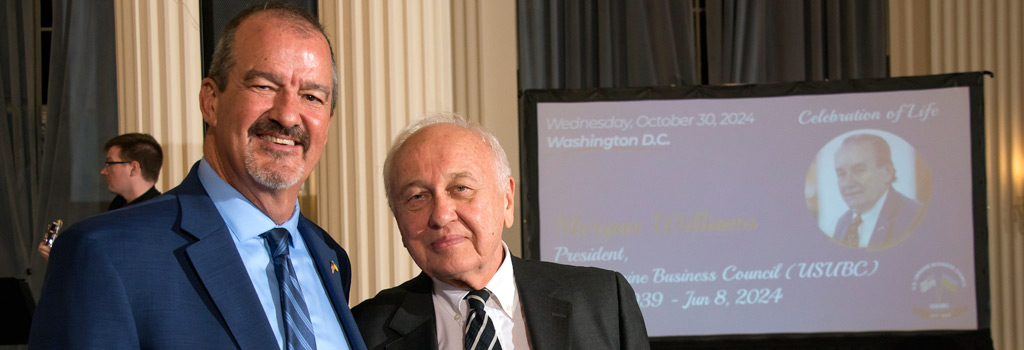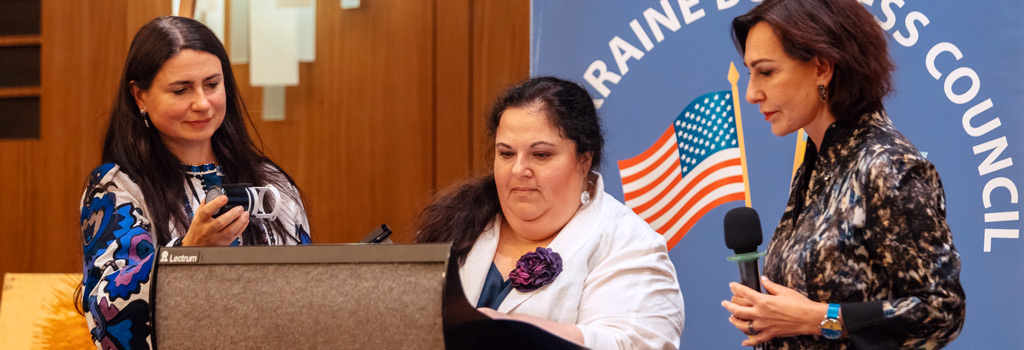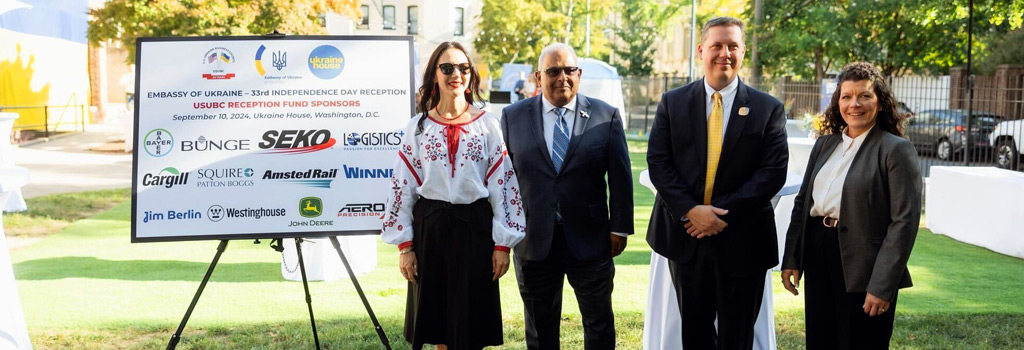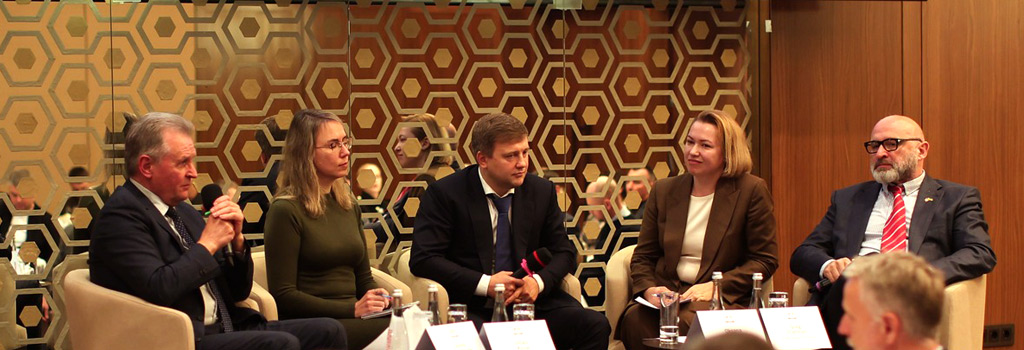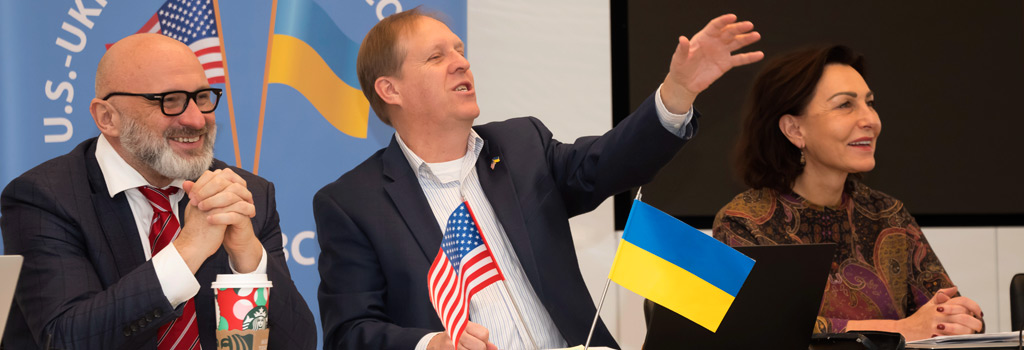Featured Galleries USUBC COLLECTION OF OVER 160 UKRAINE HISTORIC NEWS PHOTOGRAPHS 1918-1997
 Holodomor Posters
Holodomor Posters
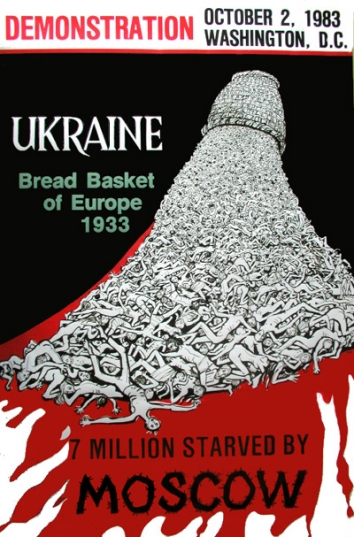
UKRAINE - MACROECONOMIC SITUATION – DECEMBER 2017
 ANALYTICAL REPORT: by Oleg Ustenko, Djulia Segura, Valentyn Povroznyuk, Edilberto L. Segura
ANALYTICAL REPORT: by Oleg Ustenko, Djulia Segura, Valentyn Povroznyuk, Edilberto L. Segura
SigmaBleyzer private equity investment management firm & The Bleyzer Foundation (TBF), Kyiv, Ukraine
LINK:Ukr_Monthly_Ec_Report_December 2017-v1.pdf
Published by U.S.-Ukraine Business Council (USUBC),
Washington, D.C., Mon, Jan 22, 2018
ANALYTICAL REPORT: by Oleg Ustenko, Julia Segura, Valentyn Povroznyuk, Edilberto L. Segura SigmaBleyzer multinational private equity firm & The Bleyzer Foundation (TBF), Kyiv, Ukraine Published by the U.S.-Ukraine Business Council (USUBC), Washington, D.C., Mon, Jan 22, 2018
WASHINGTON, D.C. - The "Ukraine Macroeconomic Situation – December 2018" analytical report with several charts and graphs is attached to this communication. The monthly Macroeconomic Situation report is prepared by the SigmaBleyzer multinational private equity firm, www.SigmaBleyzer.com, and The Bleyzer Foundation (TBF), www.BleyzerFoundation.org, Kyiv, Ukraine, who are members of the U.S.-Ukraine Business Council (USUBC), http://www.USUBC.org.
Executive Summary
- ϖ After holding a short ceasefire from the end of December 2017, in the third week of January 2018, Russian backed separatists re-started their attacks against Ukrainian militants. Russian involvement in the conflict in Ukraine has become a major concern of the US government. The US Secretary of Defense recently implied that Russia’s intention to impose Russian-friendly authoritarian regimes was the major challenge to the US, above international terrorism.
- ϖ The reform agenda in Ukraine is hindered by slow progress in fighting corruption and in judiciary system reform. Significant progress in these areas are needed to secure international assistance and pave the way for a higher growth. As a part of these reforms, Ukraine is expected to pass a law on the establishment of an Anti-Corruption Court.
- ϖ High-frequency monthly data show that Ukraine’s economic activity has continued to improve, thought at uneven rates. In November 2017, Ukrainian construction output expanded by 10.7% yoy, retail trade increased by 6.8% yoy, and passenger turnover grew by 3.6% yoy. Ukraine's industrial sector also continued its slow recovery with a growth rate of 0.3% yoy. Mining activities continued to be depressed, with coal and lignite dropping by -13% yoy. On the other hand, in November Ukraine manufacturing grew by 3.0% yoy.
- ϖ The consolidated fiscal budget (state and local) for the month of November showed a surplus of UAH 4.1billion, reducing the cumulative fiscal surplus from the beginning of the year to UAH 33.9 billion (or a surplus of about 1.2% of period GDP).
- ϖ Consumer inflation decelerated from 14.6% yoy in October to 13.6% in November. At the same time, core inflation further expanded, reaching 8.6% yoy.
- ϖ In the banking sector, bank deposits in November continued to increase, expanding by 10.9% yoy for Hryvnia deposits and by 5.4% yoy for foreign currency deposits. On the lending side, loans in Hryvnias expanded by 8.1% yoy, whereas loans in foreign exchange declined by 12.7%. The growth of money supply in November was 8.1% yoy.
- ϖ The UAH/USD exchange rate remained stable during the first half of December. However, excessive expenditures of the State Treasury related to state budget execution together with large VAT reimbursement to exporters, and increased dollar demand by importers led to a significant depreciation of the exchange rate on December 14th-18th. As a result, the UAH/USD exchange rate depreciated to 28.1 UAH per USD by the end of December.
- ϖ In November 2017, Ukraine’s current account showed a small surplus of USD 18 million compared to large deficits in previous months. This current account improvement was due to a higher growth rate in exports (11.0% mom) than in imports (3.9% mom). In January-November 2017, the cumulative deficit of the current account amounted to USD 3 billion (or 3% of period GDP). Since net financial inflows amounted to USD 450 million in November, they allowed international reserves to increase to USD 18.9 billion by the end of November 2017 (3.7 month of the future imports).
Political and Reform Developments
After holding a short ceasefire from the end of December 2017, in the third week of January 2018, Russian backed separatists re-started their attacks against Ukrainian militants and civilians in the Donetsk region. Although the intensity of attacks is lower compared to the fall of the previous year, there were several deaths among Ukrainian army forces. Thanks to significant efforts made by Ukrainian team in the Minsk’s negotiations for the release of Ukrainian militants imprisoned in Donetsk and Luhansk, an exchange of people took place at the end of December. Almost one hundred Ukrainians – including civilians who were assisting the Ukrainian army – were released from Donetsk prisons and camps. In exchange the Ukrainian side released several hundred separatists – including Russian citizens – who were caught during military actions in the Eastern part of the country.
Russian involvement in the conflict in Ukraine has become a major concern of the US government. The US Secretary of Defense recently implied that Russia’s intention to impose Russian-friendly authoritarian regimes was the major challenge to the US, above international terrorism. The urgent need to introduce a special UN military forces in the conflict zone is in the agenda of the Western leaders. In December, this was reconfirmed by the EU and the US while they re-continuing sanctions against Russia. Moreover, the US Senate has now voted in favor of providing Ukraine with lethal weapons to ensure the country’s security.
The reform agenda in Ukraine is hindered by slow progress in fighting corruption and in judiciary system reform. Significant progress in these areas are needed to secure international assistance and pave the way for a higher level of economic growth. Recent appointment of the Supreme Court of Ukraine members took place with a high rate of participation of the Ukrainian civil society. It gave an opportunity to insert into this body highly educated new-comers non-from-the-old-system. Nevertheless some questionable candidates were appointed.
As a part of the judicial system reform and fighting corruption, Ukraine is expected to pass a law on the establishment of an Anti-Corruption Court. It was a part of the requirements from both Ukrainian civil society and international partners including the EU, IMF and the World Bank. The draft law submitted to Verhovna Rada by President Poroshenko was criticized by all stakeholders since the independence of the court was not assured. There is broad agreement that the draft law should be re-drafted. A number of changes should be introduced into the draft law to make it in line with the requirements of Ukrainian civil society, the Venice Commission, EU, IMF World Bank and the US. The approval of a satisfactory law would be an important step in improving the country’s business environment.
Economic Growth
According to the latest release of the State Statistics Committee, in the third quarter of 2017, real GDP grew by 2.1% yoy, compared to an increase of 2.3% yoy in the third quarter of 2016. The mayor sources of GDP growth were gross capital formation, which increased by 7.6% yoy (compared to 35.8% yoy in Q3 2016), household consumption and general government expenditures, which grew by 5.4% yoy and 4.3% yoy, respectively (compared to 4.7% yoy and 2.0% yoy in Q3 2016).
On the supply side of GDP, the sectors that showed the largest recovery were the construction sector, which expanded by 25.2% yoy; financial and insurance activities, which increased by 8.7% yoy; real estate activities (by 6.8% yoy); information and communication (by 6.4 yoy); transportation and storage (by 6.3 yoy); and wholesale and retail trade sectors (by 5.7% yoy).
On the other hand, the following subsectors continued to have negative rates of GDP growth in Q3 2017: mining and quarrying production (-6.5% yoy); education (-5.9% yoy); electricity, gas, steam and air conditioning supply (-5.1% yoy); public administration, defense and social security sectors (-3.6% yoy); water supply, sewerage and waste management (-2.6% yoy); arts, entertainment with recreation (-2.2% yoy); and agriculture (-0.1% yoy).
High-frequency monthly data shows that Ukraine’s economic activity has continued to improve, thought at uneven rates. In November 2017, Ukrainian construction output expanded by 10.7% yoy, retail trade increased by 6.8% yoy, and passenger turnover grew by 3.6% yoy. Nevertheless, agriculture production, and freight turnover continued to show negative signs of -13% yoy and -1% yoy, respectively. Ukrainian industrial production expanded by 0.3% yoy thanks to a rise of manufacturing output by 3% yoy, while coal and lignite fell down by 13% yoy in November 2017.
Within manufacturing, the following subsectors had significant growth rates in November: chemicals (46.1% yoy), pharmaceutical products (18.9% yoy), rubber and plastic (6.8% yoy), textile (4.5%yoy), engineering (3.6% yoy), and metallurgy (2.7% yoy). However, the sectors that had negative performances were coke and oil refining (-7.6% yoy), electricity production (-6.4% yoy) and food processing (-1.1% yoy).
Regarding regional production growth, the oblasts with the largest expansion in industrial output in November 2017 were Ternopil (23% yoy); Rivne (14.4% yoy); Ivano-Frankivsk (14.2% yoy); Chernivtsi (14% yoy); Lviv (12.3% yoy); Zakarpattya (11.1% yoy); and Khmelnytskiy (7.3% yoy). On the other hand, negative rates of growth in industrial output were experienced in Luhansk (-41.0% yoy), Mikolayiv (-11.1% yoy), Donetsk (-10.3% yoy), and Zaporizhzhya (-5.2% yoy).
Fiscal Policy
In November, the state budget saw another surplus (amounting to UAH 4.1 billion) stimulated by monthly increase in revenues and declines in expenditures. At the same time, local budgets were executed with the cumulative deficit of UAH 1.4 billion. Thus the consolidated budget was in surplus of UAH 2.7 billion in November, expanding the cumulative surplus from the beginning of the year to UAH 33.9 billion (about 1.2% of period GDP).
Despite some monthly increase, state budget revenues reversed their year-over-year trend. They decline by 3.6% yoy because of negative developments in nontax revenues. Growth of tax revenues continued to decelerate (to 13.8% yoy). This was related to customs experiment within which over UAH 2 billion were transferred from the general fund of the state budget to the special fund of local budgets. Also, it was related to increased VAT reimbursements significantly exceeding the average monthly size of reimbursements in 2017 and being almost twice as high as in November 2016.
The cumulative consolidated budget revenues saw some deceleration in growth to 33.3% yoy in January-November.
Following a monthly decline, state budget expenditures experienced significant deceleration of year-over-year growth to 12.5% yoy. This was the result of significant decrease in expenditures on domestic debt servicing after restructureing of sovereign bonds in the NBU’s portfolio.
At the same time, growth of expenditures on goods and services, on current transfers, and on capital expenditures significantly decelerated. On the other hand, growth of state budget expenditures was supported by faster increase in payroll and social security expenditures. Cumulative consolidated budget expenditures grew at a pace of 23.5% yoy in January-November.
Monetary Policy
Inflation. As expected, consumer inflation decelerated in November to 13.6% yoy but remained above the forecast level. Core inflation, on the contrary, accelerated to 8.6% yoy. Faster growth of prices of foodstuffs, transport, communication, hotels and restaurants as well as exchange rate depreciation were the major reasons of consumer inflation being above the forecast. Slower growth in prices of housing and utilities as compared to the previous month (10.3% yoy vs 15.3% yoy) was the major driver of deceleration in consumer price growth in November. Other major groups of goods and services, including foodstuffs, saw little changes in prices.
Taking into account recent consumer prices developments and common price trend in December we expect consumer inflation to be around 13-13.5% yoy in 2017.
Banking Sector.
Bank deposits expanded at an accelerated pace in November. Households were the driving force of growth in national currency deposits, while corporate sector ensured faster expansion of the foreign currency deposits denominated in USD. In particular, household national currency deposits grew by 13.5% yoy compensating for deceleration in growth of corporate national currency deposits to 3.7% yoy. At the same time, corporate foreign currency deposits denominated in USD grew by 15.3% yoy more than compensating for a 2.0% yoy decline of said deposits in the household sector. Overall, in November national currency deposits expanded by 10.9% yoy, while foreign currency deposits in USD rose by 5.4% yoy. -
In November, bank lending activities continued to improve. Total national currency loans grew by 8.1% yoy. Nevertheless, this is 6.1 percentage points less than a month ago, because of sharp deceleration in hryvnia loans growth in the corporate sector, whose growth rate dropped from 13.4% yoy to just 0.3% yoy. This was partly offset by acceleration in growth of the household national currency loans by 2.6 percentage points to 26.2% yoy. The situation with the foreign currency loans denominated in USD was the opposite, with overall foreign currency loans denominated in USD declining by 12.7% yoy.
The monetary base saw deceleration in growth in both monthly terms (to 0.6%) and year-over-year terms (to 5.9%). This happened because decrease in balances at correspondent accounts of banks partially offset growth in cash resources. Money supply edged up by 0.4% mom because of moderate increase in cash outside banks and in deposits. At the same time, the over-year growth of money supply accelerated to 8.1% yoy.
Hryvnia Exchange Rate. The UAH/USD exchange rate remained stable during the first half of December. However, excessive expenditures of the State Treasury related to state budget execution together with large VAT reimbursement to exporters, and increased dollar demand by importers led to a significant depreciation of the exchange rate on December 14th-18th.
In particular, higher expenditures of the Treasury and VAT reimbursements increased the cash balances at the correspondent accounts of commercial banks in the NBU to the record high levels during the period. But banks usually transfer their excessive hryvnia cash resources into dollars. Increased demand for dollar on the side of importers is a common seasonal trend as the demand for imported goods increases on the eve of the New Year holidays. The NBU made several dollar interventions in the interbank forex market and managed to significantly slow depreciation by the end of the month. Overall, the exchange rate depreciated by around 1% to 28.10 UAH/USD.
International Trade and Capital
According to the latest NBU’s report, Ukraine’s current account showed a surplus of USD 18 million in November 2017, compared to a deficit of USD -315 million in November 2016. Hence, in January-November 2017, the cumulative deficit of the current account amounted to USD 3 billion (or 3% of period GDP).
The November 2017 current account improvement was due to a reduction in the deficit in merchandise trade from USD -713 million in October to USD -450 million in November, due to a faster rate of growth of merchandise exports (11% mom) than imports (3.9% mom). In a similar manner, Ukrainian net service trade showed higher increase in exports (by 5.6% mom), than in imports (2.9% mom). At the same time, the surpluses in the balances in net primary and secondary incomes showed short increases of USD 119 million and USD 349 million, respectively.
On a year-to-year basis, merchandise exports increased by 17.3% yoy, reaching USD 3,945 million in November 2017. The merchandise products that had the largest export growth included: machinery and equipment, which expanded by 83.4% yoy (USD 440.5 million, 11.2% share of total exports), ferrous and nonferrous metals which increased by 50.8% yoy (USD 1.1 billion, with 27% share); industrial goods which raised by 31.7% yoy (USD 53.3 million, with a share of 1.4%), chemical products by 30.7% yoy (USD 199.8 million, with a share of 5.1%), and mineral products increased by 17.8% yoy (USD 270.8 million, with a share of 6.9% of exports). On the other hand, Ukrainian agriculture products export fell down by -2.8% yoy to USD 1.7 billion.
On the import side, the largest share of imported products in November were as follows: machinery and equipment, with a share of 27% of total imports (USD 1.28 billion, growing by 20.6% yoy); mineral products, with 26% share (USD 1.23 bln, 25.9% yoy); chemicals products, with a 18% share (USD 862 million, 22.7% yoy), and agricultural products, with a share of 10% (USD 471 million, 31.3% yoy).
Regarding the geographical orientation of exports, in January-November 2017, Ukrainian exports to Europe expanded by 32.7% yoy to USD 13.1 billion and now represent 36.1% of the total exports share. At the same time, exports to the Russian Federation declined by 0.6% to a share of 8.5% the total exports. Asia foreign trade fell with Ukraine by -2.2% to a 32.6% share of the total amounts exported.
In November the financial accounts inflows amounted of USD 478 million. As a result, international reserves increased to USD 18.9 billion, enough for 3.7 months of future import requirements.
NOTE: The entire Macroeconomic Situation Report for December 2017 can be found in the attachment Ukr_Monthly_Ec_Report_December 2017-v1.pdf
=================================================================
NEWS: For the latest news about Ukraine go to the KYIV POST website: www.KyivPost.com.The Kyiv Post of the ISTIL Group is a member of the U.S.-Ukraine Business Council (USUBC).
=================================================
U.S.-Ukraine Business Council (USUBC)
"A strong international voice for business in Ukraine for over 20 years"
Washington, D.C., mwilliams@usubc.org; www.USUBC.org=================================================
Power Corrupts & Absolute Power Corrupts Absolutely.
=================================================
NOTE: If you do not wish to be on the U.S.-Ukraine Business Council (USUBC), distribution list please write to usubc@usubc.org.








